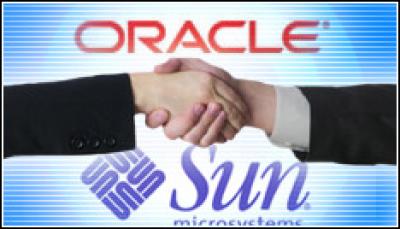McNealy And Ellison Share Stage At Java One

Ellison said the new Oracle will consider building Java-powered netbooks and phones
Oracle CEO and founder Larry Ellison, in his first public appearance since Oracle announced April 20 that it intends to acquire Sun Microsystems for $7.4 billion, told a packed auditorium in an informal appearance onstage at the JavaOne conference in San Francisco that his new ownership will continue to invest heavily in Sun’s Java franchise.
Ellison also said—almost in an offhand way—that the new Oracle may get into the Java-powered netbook- and telephone-making businesses at some point.
Ellison, noting that “all of our middleware is based 100 percent on Java,” said his company has “invested more than anybody else in Java technology in terms of dollars over the years, and we intend to invest—and accelerate our investments—going forward.”
Java, Sun’s open-source networking programming language, is found in most IT systems, throughout the Internet and in millions of handheld devices worldwide.
Sharing the stage, Ellison and Sun Chairman Scott McNealy, however, chose not to discuss the future of Sun’s hardware businesses, which include processors, servers, storage arrays, network switches, thin-client terminals and a number of other items.
“Let’s focus mainly on Java here today, that’ll keep us out of trouble,” McNealy joked.
Since the announcement of the acquisition, there has been speculation by analysts and industry insiders that Oracle may want to break off Sun’s hardware franchises and sell them to other vendors. Ellison, however, said shortly after the transaction was announced that he intends to do no such thing.
Java is very attractive for Oracle “because it allows us to extend our own platform and build applications on top of it,” Ellison said.
“Our whole next generation of business applications, something we call our Fusion Suite of applications, is built entirely on Java. This will be the first-ever set of ERP and CRM applications built on a standard platform,” Ellison said. “We were able to do that because Java is open and extensible.
Ellison added that his engineers have contributed a great deal to the Java franchise over the years.
“We had to add to Java such things as real-time business activity monitoring, business intelligence—a variety of things—and we could do that because Java is open,” Ellison said. “Customers and ISPs can do the same things for their own applications.”
Ellison also told about 3,000 Java developers at the conference at the Moscone Center that he may steer Oracle toward new businesses making Java-powered netbooks and telephones to compete with Hewlett-Packard, Acer, Lenovo, Dell and other companies.
“I don’t see why some of those devices shouldn’t come from Sun,” Ellison said. “There will be computers that are fundamentally based on Java.”
Netbooks are smaller, relatively inexpensive laptop computers with wireless connectivity that are good for checking e-mail and browsing the Web. Analysts expect the netbook market to grow to about 25 million units sold in 2009, up from 11.7 million in 2008.
Ellison and McNealy did not address any of Sun’s other open-source software projects, such as MySQL (database), the NetBeans software tools and several others.
McNealy said when Sun’s and Oracle’s research and development divisions join together in the merger, the R&D budget will total between $4 billion and $5 billion per year, ranking it among the world’s top 10 companies.
“That is a very, very positive future for Oracle,” McNealy said.